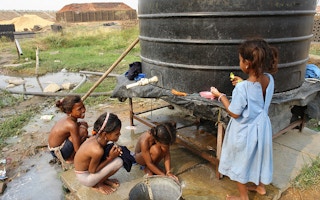Indian officials launched investigations on Wednesday into child deaths in India’s mica mines after the Thomson Reuters Foundation revealed children were being killed in illegal mines and their deaths covered up.
A three-month investigation in the mica-producing states of Bihar, Jharkhand, Rajasthan and Andhra Pradesh found at least seven children have been killed since June, mining for mica, the valued mineral that puts a sparkle in make-up and car paint.
But these deaths have gone unreported as victims’ families and mine operators do not want to end the illegal mining that is the only source of income in some of India’s poorest regions.
Nobel laureate Kailash Satyarthi’s child protection group Bachpan Bachao Andolan (BBA) said these deaths in unregulated mines falling into disrepair were just the tip of the iceberg and estimated fewer than 10 per cent of mica deaths are reported.
Jharkhand’s Minister of Labour, Raj Paliwar, said on Wednesday he was launching an investigation immediately.
“I have ordered a probe. I have directed the Labour Commissioner to investigate and submit a report,” Paliwar told the Thomson Reuters Foundation.
“Children engaged by anybody as child labourers is illegal and we will take strong action against such people whoever they may be and however powerful they are.”
“
The authorities should immediately investigate violation of rights, shut down illegal mining and evaluate the failures to keep children in schools instead of being employed in the worst forms of labour.
Meenakshi Ganguly, South Asia director, Human Rights Watch
Iqbal Khan, joint Secretary of Mines in Rajasthan, said the authorities were unaware of child workers in mica but would investigate.
“We will look into the matter and take necessary action,” he told the Thomson Reuters Foundation.
Schooling not mining
India is one of the world’s largest producers of mica but it is estimated 70 per cent of its output comes from illegal mines, many abandoned in the 1980s and 1990s due to stricter laws on deforestation and the discovery of lower cost mica substitutes.
By law children in India below the age of 18 cannot work in mines and other hazardous industries but many families living in extreme poverty rely on children to boost household income.
Investigations by the Thomson Reuters Foundation found children working in and around mica mines in northern Jharkhand, southern Bihar and in Rajasthan in India’s northwest.
Dutch campaign group SOMO estimates up to 20,000 children are involved in mica mining in Jharkhand and Bihar.
Y.S. Kataria, spokesman for the Ministry of Mines, said child labour in mica mines was a serious issue.
“Children have to be protected from being exploited like this,” he said.
“The government is taking steps to stop all illegal mining. For example, we are currently developing technology where we can monitor legal mines and identify illegal ones using satellites.”
Kariya Munda, parliamentarian for the ruling Bharatiya Janata Party from Jharkhand state, voiced his concern but also expressed the difficulty in tackling this issue with illegal mining the lifeline for many families.
“I am aware that illegal mining is going on, but I also understand this is a matter of livelihood for many people since there are no other alternatives in these areas,” he said.
“The central and state governments should work together to solve this problem.”
Other Indian officials expressed concern about the deaths of children in mining of mica, a grey, crystalline mineral that has gained prominence in recent years as an environmentally-friendly material, used by major global brands in the car and building sectors, electronics and make-up.
State governments in India are facing pressure from mining companies and activists to grant licences to illegal mines to crack down on the black market and child labour in mica but also provide training in other industries and schooling.
Meenakshi Ganguly, South Asia Director of Human Rights Watch, said this investigation exposed concerns both about right abuses around illegal mining and the risk to child workers.
“The authorities should immediately investigate violation of rights, shut down illegal mining and evaluate the failures to keep children in schools instead of being employed in the worst forms of labour,” she said.
Save the Children India’s Advocacy Director Bidisha Pillai said reports showing child labour is rampant in mica mining should force the government to take immediate remedial steps.
“The government needs to check and halt the involvement of children in labour in these mines, which are functioning without regulations and precautionary practices of any kind, impacting the safety and well being of children they illegally employ,” she said.
This story was published with permission from Thomson Reuters Foundation, the charitable arm of Thomson Reuters, that covers humanitarian news, women’s rights, trafficking, property rights and climate change. Visit http://news.trust.org










